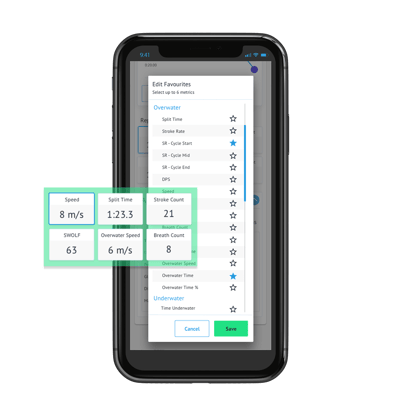What if you could have quick access to insights for each lap/rep unfold right at the palm of your hand? With the ‘’favourite metrics’’ that is precisely what you can do during a live workout or on your past activities feed.
You can track and measure your performance in each of your six favourite metrics for every rep/lap. This detailed breakdown will show you your strengths, weaknesses and what to improve on to swim faster.
What metrics to choose as your favourite?
By default, there are six favourite metrics already chosen in the app. There is a metric selected from every phase (transition, underwater, overwater). These metrics serve as an excellent foundation on what to aim to improve first. You can always change and customize your favourite metrics display.

However, it is good practice to spend time establishing an understanding of your performance in each metric before changing them. The time you spend will enable you to dissect and analyze each swimming component and give you insight into your swimming profile. Over time, you can dive deeper into your data and incorporate other metrics.
What metrics you choose will largely depend on your short-term and long-term goals. You will need to communicate with your Coach to make sure that goals and training scope are aligned.
How can tracking favourite metrics help you achieve your goals?
1. Short-term goals.
Observing short-term changes in metrics allows for the tailoring of everyday workouts. For example, if the set’s goal is to work on high-intensity reps, then you would want to track your overwater speed, stroke rate and distance per stroke (DPS), among other metrics. As you increase the stroke rate, you will notice a small drop in DPS. A small trade-off between metrics is bound to happen. The key is to strike the right balance between metric trade-offs. If speed decreases due to an increase in stroke rate, there was too much of a DPS decline.
2. Long-term goals.
Long-term tracking allows you to see if you are still on track with your ultimate goals. Are your short-term goals bringing you closer to your long-term goals? Tracking progress over an extended period will keep you accountable for your goals.
Tracking your favourite metrics during test sets is a great way to determine where you stand today and use it as a benchmark to gauge your long-term progress. Test sets will allow you to track changes in metrics and overall performance over time.
Key takeaway
Keeping track of metrics allows you to review your workouts and exchange insights with your coach. Training data gained from different metrics can provide even more insight into ways to improve overall performance.

.png)

.png)

.png)